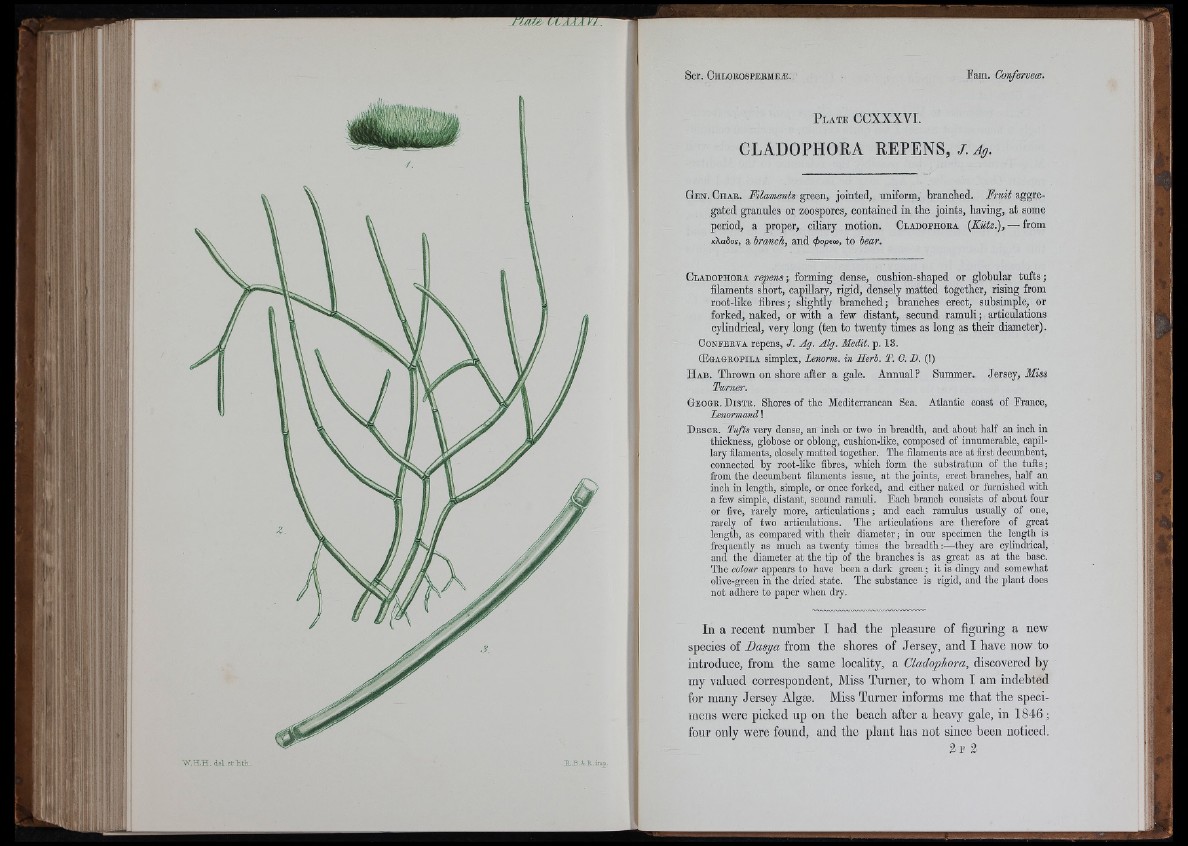
yii''
ii'|f=t
\n ,
M
W .H .H . d e l.e tR th .. R.B.tX.imj.
P l a t e CCXXXVI.
CLADOPHORA REPENS, /. Ag.
G b n . Chak. Mlaments g re e n , jo in te d , u n ifo rm , b ran ch ed . Mruit a g g re g
a te d g ra n u le s o r zoospores, co n ta in e d in th e jo in ts , h av in g , a t some
p e rio d , a p ro p e r, ciliary m o tio n . Cladophoea {Kütz.), — from
kKoSos, a branch, an d éopem, to bear.
Cladophoea repens; forming dense, cushion-shaped or globular tufts;
filaments short, capillary, rigid, densely matted together, rising from
root-like fibres; slightly branched; branches erect, subsimple, or
forked, naked, or with a few distant, secund ramuli ; articulations
cylindrioal, very long (ten to twenty times as long as their diameter).
Conpeeva repens, J. Ag. Alg. Medit. p. 13.
CEgagkopila simplex, Lemrm. in Hei-b. T. 0. B . (!)
Hab. Thrown on shore after a gale. Annual ? Summer. Jersey, Miss
Turner.
Geogk. D is t k . Shores of the Mediterranean Sea. Atlantic coast of France,
/!
Desok. Tufts very dense, an inch or two in breadth, and about half an inch in
thickness, globose or oblong, cushion-like, composed of innumerable, capillary
filaments, closely matted together. The filaments are at first decumbent,
connected by root-like fibres, which form the substratum of the tufts ;
from the decumbent filaments issue, at the joints, erect branches, half an
inch in length, simple, or once forked, and either naked or furnished with
a few simple, distant, secund ramuli. Each branch consists of about four
or five, rarely more, articulations ; and each ramulus usually of one,
rarely of two articulations. The articulations are therefore of great
length, as compared with their diameter ; in our specimen the length is
frequently as much as twenty times the breadth :—they are cylindrical,
and the diameter at the tip of the branches is as gi-eat as at the base.
The colour appears to have been a dark green ; it is dingy and somewhat
olive-green in the dried state. The substance is rigid, and the plant does
not adhere to paper when dry.
In a recent number I had the pleasure of figuring a new
species of Basya from the sliores of Jersey, and I have now to
introduce, from the same locality, a Cladophora, discovered by
my valued correspondent. Miss Turner, to whom I am indebted
for many Jersey Algse. Miss Turner informs me that the specimens
were picked up on the beach after a heavy gale, in 1846;
four only were found, and the plant has not since been noticed.
2 e 2
’II f l
fill
il